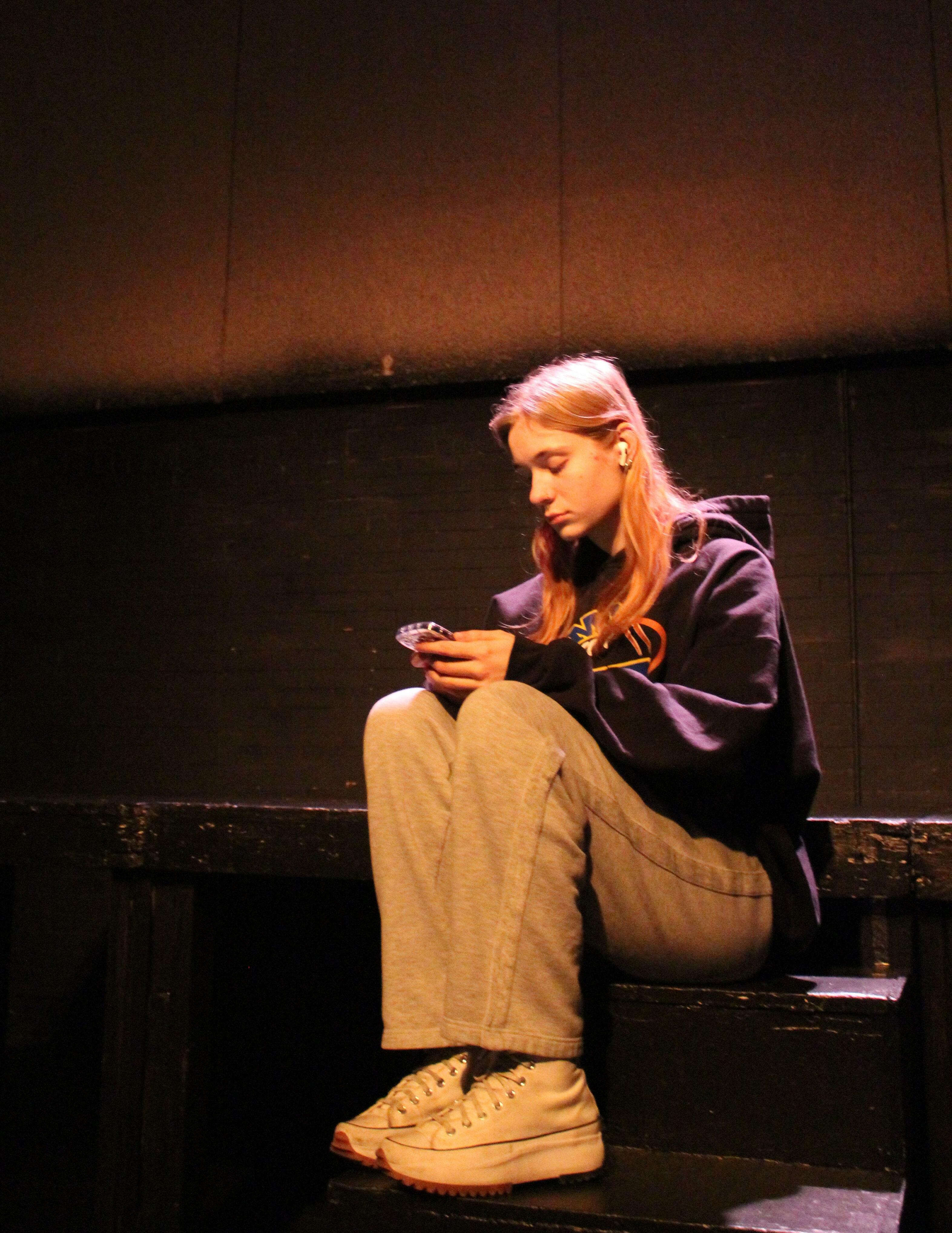










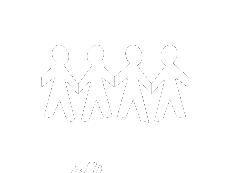




echo Volume 108 Issue 7 January 2023 100 Selma Ave. wgecho.org
Staff
EDITOR-IN-CHIEF:
Lydia Urice
PRINT EDITOR:
Izzy Poole
JUNIOR EDITOR:
Hadley Hoskins
SOCIAL MEDIA MANAGER/ GRAPHICS EDITOR:
Maren DeMargel
VIDEO EDITOR:
Luca Giordano
NEWS/OPINION EDITOR:
Ali Schulz
SPORTS EDITOR:
Owen Crews
PODCAST EDITOR:
Sam Klein
FEATURE ENTERTAINMENT EDITOR:
Joe Harned
BUSINESS MANAGERS:
Soledad Lee
Dakota Motley
TIKTOK/ PUBLIC RELATIONS MANAGER:
Eleanor Kanerva ADVISOR:
Donald Johnson
SOME MATERIAL FROM TRIBUNE NEWS SERVICE
The Echo is a monthly publication of the newspaper staff of Webster Groves High School, 100 Selma Ave., Webster Groves, MO.
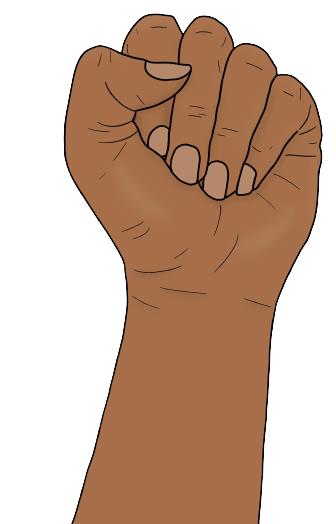
To contact staff members, call 314-963-6400 ex. 11157 or write to wgecho@wgmail.org.
Unsigned editorials are the opinion of a majority of staff members; signed articles are the opinion of the writer
Letters to the editor of 300 words or less are welcome; submit letters by the 10th of the month to wgecho@wgmail.org, or room 155. All letters must be signed, although the name may be withheld from publication if requested. The Echo has the right to edit letters for publication as long as intent remains unchanged.
The Echo is a member of Quill and Scroll, JEA, MIJA, NSPA and CSPA.
Editor’s note: For this issue The Echo deals with topics that could be considered triggering. All who requested to be anonymous are anonymous. Stories that we deemed triggering have content warnings.
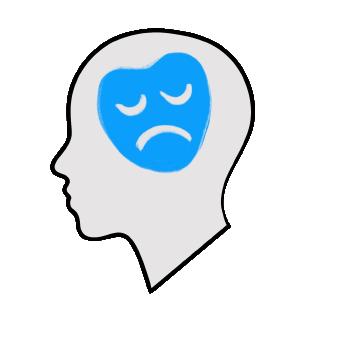
Athletes overcome sports injuries

Harassme nt, assault leads to distrust
Environmental causes need to be taken seriously
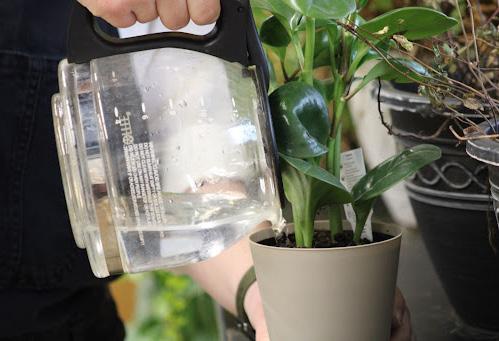
School calendar affects finals
Physical activity improves mental health
Students share experiences with eating disorders
New RSO excited to connect with students
Cancer survivor gives back to community
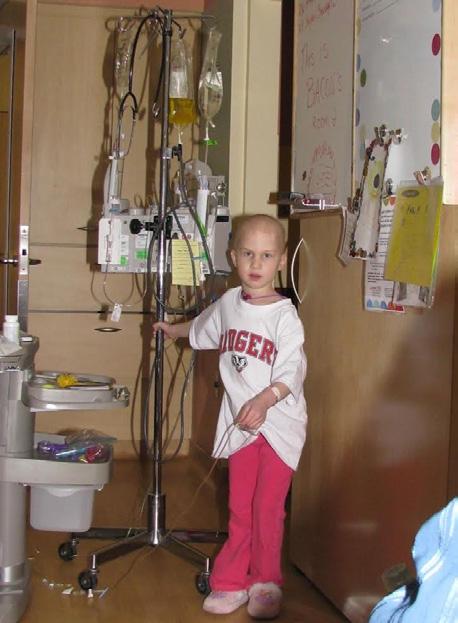

Music helps students cope with stress
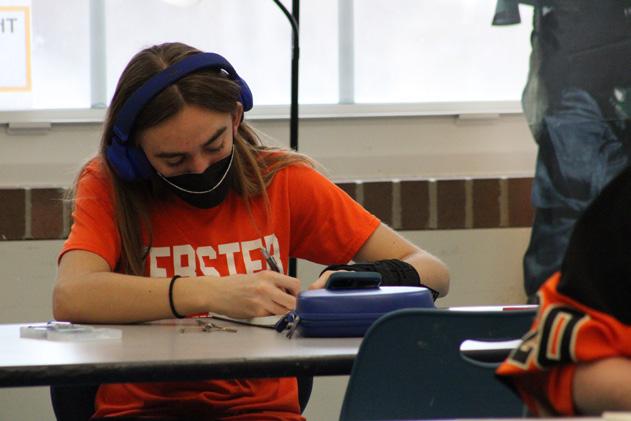
Creativity keeps students healthy
Type 1 diabetes affects student lives

Students discuss effects of New Year’s resolutions
School needs to better regulate the workload for students

2 wgecho.org Table of Contents | January 2023 3 4 5 6 7
10 11 12 13 14
8,9
15 16
theecho
15 14 10 12
Cover cutline: Senior Robyn Foley scrolls on her phone as art depicts stressors a teenager might face.
5 4 11 7
Photo by Maren DeMargel. Art by Canva
Athletes overcome sports injuries
Luca Giordano Video Editor
Minor injuries occur often in athletic careers, but when injury severity means sitting out of physical activity, injuries can have mental effects on players.
Among Webster athletes, sophomore Seth Parrish, senior CJ Lang and senior Allie Miller all picked up knee injuries ranging in severity, from a minor sprain to an anterior cruciate ligament (ACL) tear.
Miller is a two-sport athlete, playing basketball and soccer. Miller’s injury developed through what she thought was a recurring knee problem, picking up injuries three separate times over the course of a year, with her first coming in May 2021 and her last in May 2022.
Miller was keen on playing through her injuries because she did not want to quit playing soccer.
“I had just joined a new team last year, so I was really trying to meet the people on the team, and I didn’t want to stop playing soccer, so I thought that it was just like, ‘Oh, I just have knee problems.’ I didn’t think that I would have something structurally wrong,” Miller said.
After her third injury, Miller went to get an MRI, where Miller learned she had torn her ACL and her meniscus, and would miss nine months of sport.
“I was so shocked, and my dad had a conversation with me in the car about how I don’t have to stop playing just because of this, and then I got home, and I cried,” Miller said.
Lang plays basketball and picked up a lateral meniscus tear on his left leg Nov. 4, the first day of practice for this season. While making a quick cut, Lang’s knee buckled, but as he continued to play on his injured knee, he had to decide on whether he would get surgery or continue playing through the injury.
“I had to either pick between trying to play on it all season or to get the surgery, and ultimately, I just got the surgery. I wouldn’t have been able to play the same if I hadn’t,” Lang said.
Lang received surgery on Nov. 22, and began physical therapy a week after.
Parrish is on the wrestling team and got a sprained knee in practice Jan. 14, when a teammate bigger than he put too much weight on Parrish’s leg. Although he picked up a minor injury and expects to be better in a week, Parrish’s injury has affected his confidence during practice.
“It feels like I can’t walk, so when I’m sprawling on opponents, I just get that mentality that my leg hurts,” Parrish said.
Parrish plans to play through his injury, tending to it on his own with ice and elevation.
“I can’t give up wrestling right now. I’m in a good state. I don’t want to stop, and I’m so afraid to stop,” Parrish said.
After receiving surgery for their injuries, Miller and Lang went to physical therapy to work on getting muscle back. Miller and Lang worked to rebuild lost muscle in their legs with different workouts.
“If I was wearing shorts right now, you would see my left leg is significantly skinnier and smaller. It still is, and it’s been six months. When it (surgery) first got done, there was no definition in any of my leg, I looked like I had no muscles because I didn’t. I had lost it all,” Miller said.
“In the beginning it (recovery) was hard because I had lost most of the muscle in my quad, because my whole quad and my knee kind of shut down,” Lang said.
Miller is six months into her recovery after receiving surgery July 25. After three months of recovery, Miller’s knee brace came off and she started to work on squats and body weight exercises.
Although Miller will miss this basket-

ball season, she hopes to play soccer in the spring.
“I don’t know if I’ll be ready, but I’m going to try,” Miller said.
After six weeks of injury Lang returned to the court Dec. 16, during the Varsity Shootout against Bishop Miege at the Mizzou Arena.
“When I first got surgery and was contemplating just playing through it or not, I was wondering, I was always asking myself if I could ever go back to the way I played before, but honestly, now that I’m playing again it hasn’t really changed. I’m back in the same mindset I was before the injury,” Lang said.
wgecho.org 3 January 2023 | Feature
Senior CJ Lang goes up for a layup against Kirkwood, Jan. 10. Lang returned to the basketball court Dec. 16, after a knee injury that saw him out for six weeks.
Photo by Eleanor Kanerva
Harassment, assault leads to distrust
Izzy Poole Print Editor
Content warning: This story mentions of sexual assault, sexual harassment and rape.
“One of the things that hurts the most is the friends who don’t believe you, or maybe they do believe you, but they just don’t care,” an anonymous student said about sexual assault.
The Equal Employment Opportunity Commission defines sexual harassment as, “Sexual harassment includes unwelcome sexual advances, requests for sexual favors, and other verbal or physical harassment of a sexual nature in the workplace or learning environment.”

The difference between sexual assault and sexual harassment is that sexual harassment is the broad term that includes multiple kinds of unwanted verbal and physical sexual attention from the harasser. Sexual assault is sexual contact or behavior that is most often physical without consent from the victim.
Sexual harassment can occur in different circumstances and to any gender. There are different forms of sexual harassment and ways that it shows up: for example, any unwanted sexual advances or touching/contact or photos/ messages, pressure to engage with some one sexually, making situations depen dent on sexual favors, talking about sexual relations in inappropriate plac es, and verbal harassment including jokes about sexual acts.
Students feel unsafe even just walking from class to class. For ex ample, this reporter observed a stu dent yell, “You make me want to rape somebody,” while receiving their keys after their friend had taken them and ran away with them. Also another student said, “Bro, stop looking at her a** like that,” while laughing.
In the aftermath of sexual assault, victims can feel unsupported. “I expected the justice system to let me down, but I expected more from my friends. It also really doesn’t matter how much proof you have; it all depends on whether they decide to actually care, which quite frankly they don’t,” the anonymous student said.
The student shared their opinion on how so ciety views sexual assault. “I think that it is very frustrating to go through the process of reporting, but also even just telling people gets incredibly frustrating because people constantly tell you to speak up, or to keep telling people until they believe you. In reality even when people believe you, the issue is, do they care enough to do anything or do they care at all? Because
they can fully believe you or know that you’re telling the truth but really just don’t care.”
The student said how the school handled their case seemed to prove their point.
“The only reason I told the school was in the hopes that there would be some sort of change or action that was taken. In reality they didn’t do a whole lot, and the teacher that I told really let me down. The school always says that you should have trusted adults, and I told this person, and he quite frankly did not care, and I felt really let down by that person, so I feel like my view of the school has definitely changed in their ability to handle situations like that,” the student said.
The teacher who wished to remain anonymous said via email, “While I certainly can’t speak about any specific students, all teachers here value (and work to cultivate) the trust of students. Sometimes that trust manifests itself in the delivery of very good news, and sometimes we also receive troubling or concerning information. We have a personal, professional and legal obligation to act on troubling information, and given our relationships with students that sometimes requires further care and management. I’m sure ANY adult in our school would act in a caring fashion that reflects the gravity of the situation.”
The student said the administration failed to make them and others involved feel safe.
“I still have classes with this person, or people who I know who were also affected by that situation still have classes with this person, and even telling the school they had to make all kinds of calls and have me report it to people I didn’t want to tell in the first place,” the student said.
“Truthfully if I could go back, I probably just wouldn’t have told the teacher that I told at all because at this point if feels more humiliating to see that person everyday and know that he knows that about me, but just doesn’t care to do anything, than it does to not have done anything at all,” the student said about the repercussions.
All teachers and employees have training to recognize distress in students and the reporting procedures. It’s a general training all employees get, but not necessarily specific for being a trusted adult.
“When staff members are aware of any type of abuse from a student, they are trained and legally mandated to report that concern. The report is then shared internally to appropriate counselors, law enforcement, social worker, building and district administrators as well as parents. Depending on the circumstances, additional support may be undertaken,” principal Matt Irvin said about protocols for teachers via email.
4 wgecho.org Feature | January 2023
Art by Izzy Poole
Environmental causes need to be taken seriously
Arianna Peper Contributing Writer
It is easy to think one person can’t make a big difference when it comes to the environment. However, contributing in small ways can make a difference.
In 1972, the United Nations held the first conference that made environmental issues widely known.
Today, the planet is still not in the best position because of the ozone layer being damaged, air pollution and a constant amount of garbage being disposed of in wildlife and oceans.
Though climate change is connected to many causes, such as generating power, oil drilling, and consuming too many natural resources, it can also be related to people’s daily choices.
One issue at Webster is that there are no recycling or compost bins easily available in the cafeteria. This results in students only being able to throw away all of their items, therefore contributing to waste disposal.

According to National Geographic, the world generates around 3.5 million tons of plastic and other solid waste daily, which shows how important it is for people to make small changes to their daily activities.
One small way to contribute to the cause of lowering the waste disposal rate is WGHS including compost and recycling bins in
the cafeteria and courtyard, making them more accessible to students.
Currently, the Environmental Club has received a grant from the Webster Groves Women’s Garden Association and is planning to grow native plants in a garden at the school, but even with that being done, sponsor Elizabeth Hobbs said there absolutely needs to be more done for the environment.

Hobbs said students can make more environmentally friendly choices by trying not to consume in the first place. This means that instead of buying plastic water bottles, they should invest in reusable ones and focus on purchasing items ethically from the USA rather than overseas.
Clothing is also a large part of waste contributing to landfills. The manufacturing process wastes a lot of water.

According to “The Fashion Law” and “The 71 Percent,” it takes around 1,800 gallons of water to grow the cotton required to make just one pair of blue jeans.
Rather than throwing away old jeans or clothes, Hobbs said students can donate or sell them. She mentioned how students should focus on being okay with purchasing used clothes to be more environmentally friendly.
Hobbs said, “I think that climate change is overwhelming, but small changes do make a difference. It’s like one large rug and if everyone pulls a thread, eventually it will come undone.”
Op-Ed
Senior Arctic Grosvenor waters a plant at the environmental club meeting on Jan. 24. Grosvenor said, “We live on this earth, and it’s on a timer now, and I think we should do all we can to make that timer longer.”
WEBSITE wgecho.org wgecho.org 5 January 2023 | Feature
Photo by Arianna Peper
VISIT OUR
School calendar affects finals
Soledad Lee Business Manager
Sam Klein Podcast Editor
First semester finals take place the week before winter break. This year winter break started on Dec. 22.
Some teachers posted grades the day their finals were taken, while others waited until grades were due. This left students wondering what their final grade would be in each of those classes and how it would affect their GPA.
About when she thought grades should be posted, junior Ruby Coalier said, “I think before break because it adds unnecessary stress throughout break and going into second semester. I feel like it should be a clean slate cuz I found out two of my final grades once I got back.”
Skylar Moore, junior, agreed, “I prefer for my grades to be finalized, if you can’t do it before break, at least towards the beginning of it. Not at the end. Absolutely not at the end.”
“It makes me really anxious because I either think that I’m at the bottom of the line which kind of makes me doubt myself more than I do when it’s at the beginning because I have less time to stress and think about it,” Moore explained.
Teachers have preferences on when finals should be graded as well.
To some it is important to prioritize their time over break and get the grading done before.
“Always before break. Over break I just want to have nothing on my mind related to school, and just really get away from it for a couple of weeks,” German teacher Brent Mackey said.
Math teacher Justin Mathes tries to get most of his grading done before break, but sometimes finishes grading around Christmas. Mathes reflected how he is glad this time around, wasn’t like the year with COVID and finals.
“I’m really just glad that it’s unlike the COVID year, when we had finals after break. That was not ideal, in my opinion, to have the gap and then have the finals, so I’m really glad we’re back to the traditional finals, before the break schedule,” Mathes reflected.
“The ones earlier in the week I tend to grade, but I didn’t put them all in until the day before,” Latin teacher Jeff Smith said about how he prefers to put grades in at the end of break.
There is a question of whether the subject matters considering many English teacher’s finals include essays where some other subjects have multiple choice exams.

“I’m not sure I have a preference. Different finals would be dependent on what you teach like an English teacher would probably need more to grade an essay than I did in a particular format, so it made it a little easier for me to get mine grade soon, so I don’t have a preference,” science teacher Greg Heard said.
As many people like Mathes remember, during COVID, fall second-term finals fell after break. Teachers were surveyed about this being a possible option due to the fact that the fall semester is two weeks shorter than the spring semester.
“Now what can I say about the two week discrepancy? I know that there was discussion of having finals after break verses having them prior to break which I think most staff would agree. I actually think students would agree too, having them prior to break ultimately results in higher scores,” Spanish teacher and NEA representative Jaime Adamski said.
6 wgecho.org Feature | January 2023
Art by Frances Baken
Physical activity improves mental health
Soledad Lee Business Manager
Some students search to stay physically active during the school year. Seeing different ways they stay active and how this affects their daily lives is important.
One thing to consider is students’ and teachers’ mental health, which aligns with something like physical activity.
“I try to exercise daily before school. You know coaching basketball, you’re still pretty active; you’re up and moving. According to my Fitbit I can get 10,000 steps in a game,” math teacher Justin Mathes said.
“Regular physical activity can help adolescents improve cardiorespiratory fitness, build strong bones and muscles, reduce symptoms of anxiety and depression, and reduce the risk of developing heart conditions like heart disease, cancer, Type 2 diabetes,” according to the Centers for Disease Control and Prevention (CDC.)
De Smet High School junior Quinn Gaffney notices that staying physically active throughout the year is beneficial to his mental health.
¨Oh my gosh, it’s (physical activity) the singlehanded most amazing tool in my arsenal, that I have to deal with any mental issue I’m going through right now at the moment. Like anytime I’m sad or angry, I can direct that energy into something good, like working out or playing a hockey game,¨ Gaffney said.
Senior Oliver Doyle stays active playing soccer in the fall. In the winter, Doyle works out after school and in the spring he plays club soccer and runs track.

During the year, Doyle’s mental health is affected by being active.
“I think it makes me less stressed and happier because I’ve gotten out some of my energy,” Doyle said.
“Then I workout pretty much all year round, yeah at the WG Rec Center. I workout pretty much… During my peak I’ll workout three-four days a week, cycling pretty much all body groups,” Gaffney said.
The Webster Groves Recreation Center is a place with a fitness center which some students use to workout.
“I stay active when my sports aren’t in season by going to the gym,” junior Lauryn Riefle said.
Students are also provided with the opportunity and are required to take Physical Education electives. Those include Physical Education, Weight Training, Kinetic Wellness and Lifetime Fitness.
¨Well, I take weight training as an elective class, and I also workout on my own time,¨ junior Joe Callas said.
Women’s basketball coach Annie Lybarger makes sure to get all her working out done in the morning, planning workouts ahead.
Gaffney reflected how doing different sports or activities throughout the year keeps everything balanced.
¨Late spring I’ll do inline hockey, and I also climb throughout the year. It kind of balances out the cardio of hockey with more of a dynamic movement, power, sport,¨ Gaffney said.
¨I definitely think it’s nice to take a break from school sometimes and get out and do sports, and then it just kind of refreshes your brain,¨ junior Shea Goggin said.
wgecho.org 7 January 2023 | Feature
Senior Oliver Doyle fights an opponent for possession of the ball in the second District game against Lutheran South High School on Nov. 1, 2022. The Statesmen won with a score of 7-0.
Photo by Hadley Hoskins
Students share experiences
Maren DeMargel Social Media Manager
CONTENT WARNING: contains mentions of eating disorders, vomiting, anxiety and weight gain.
“I am unable to concentrate on anything other than the way my body feels,” an anony mous sophomore female said.
“It consumes all of my thinking and makes it hard to focus on any thing else,” she said of her anorexia, an eating disorder cat egorized by restric tive eating in an effort to reduce body weight.
According to Claire McCarthy, MD, senior faculty editor of Harvard Health Publishing, “One in seven men and one in five women experiences an eating disorder by age 40, and in 95% of those cases, the disorder begins by age 25.”
In a survey done of 83 Webster Groves High School students, 31% said that they had suffered from an eating disorder at some point.
Types of disorders experienced by students included anorexia, binge eating disorder, restrictive food intake and more.
An anonymous student suffered from bulimia, an eating disorder where one self-induces vomiting or purging after meals. After quitting a sport that required frequent physical activity, the student experienced weight gain.
“My self confidence and body image hit an all time low,” the student said, “and I began Googling ‘lose weight fast tips’’ and eventually decided to start counting calories, which led to me
making myself throw up if I’d go over my limit.”
The student’s overwhelm ing desire to lose and maintain a low body weight began to disrupt their health and life.
“I lost weight fast, which made me proud of myself. This pride became an addic tion quickly and with a cost. My hair started falling out; I would often feel faint and even sometimes pass out. Even though in the mirror I looked skinny, I was the least healthy I’d ever been,” the student said.
Not only was the student’s physical health af fected, but their mental health began to de cline as well.

“Disordered eating added a new layer of anxiety I had never experienced, anxiety that I would eat too much or anxiety that I would regain the weight,” the student said. “I began resenting people who had the body that I wanted. Many of my close friends are very skinny or had perfect bodies, at least in my eyes, and I became a very vain and envious version of myself I barely recognized, inside and out.”
Disordered eating even affected this student’s experience at school, as they would leave the class after lunch each day to purge themselves of what they had just eaten.

“This took time out of the classroom and also would leave me shaky and often distracted in classes,” the student said.
This student is not the only student who has had their lives completely altered by disordered eating. An anonymous senior female suffered from binge eating disorder, a disorder characterized by consuming large amounts of food in one sitting and feeling a lack of control surrounding this behavior.
This senior began experiencing changes to her eating habits during the COVID-19 lockdown in the 2020-2021 school year.
“I was bored, and I was upset, and I was sad, so I turned to eating to cope,” the senior said. “All my other friends were taking this time to workout, so I was super driven to eat healthy and not

8 wgecho.org January 2023 | Feature
Spreading awareness
“I don’t even understand or recognize myself”
- anonymous sophomore female
experiences with eating disorders

eat that much during the day, but then I’d get hungry and upset with myself and binge at night. It was just this process of having hope and just disappointing myself every day.”
Over the course of seven months, this senior gained 40 pounds due to this binge eat ing. Suddenly, she didn’t rec ognize herself, leading to a decline in mental health, es pecially once she was back
“I was just always uncomfortable, like I would catch a glimpse of myself

She be gan to feel ostracized, spe cifically within her
“I felt like the odd man out. They would always just ask, ‘Are you really hungry? Do you really want seconds?’ It wasn’t them that I hated, but it was the idea that I knew people were noticing and watching and that people had judgments around that,” the senior said. “They would go get ice cream and be like, ‘No, you don’t need any,’ things like that. It was just kinda hard, and they just didn’t really know what to do.”
However, the senior doesn’t blame them for making her feel ashamed. Instead, she offers advice.
“I can imagine how hard it is to be in my family’s position where they just don’t know what to do. How are they supposed to know what I want them to do if I don’t tell them? Communi cation is really important between the people around you and yourself,” she said.
With an increase in communication, the senior was able to ask for help. Her family helped her find a nutritionist who helped her plan meals and restore her relationship with food and eating. While the road to recovery was not easy nor linear for this senior,

the results were astounding.
“Now after recovery, I am really proud of myself, and I feel really powerful,” the anonymous senior said. “I feel empowered because I know I have the willpower. I know I can do really
The aforementioned student who suffered from bulimia was also hesitant to ask for help, but once they told their parents about their disorder, they regretted not doing so sooner.
“I decided to tell them once I already had dealt with the worst of it. I wish I had told them sooner because they were very understanding and more than happy to
offer their support. I know when you are dealing with a bad episode, or a day where you just feel horrible about your body, it’s hard to stop yourself from these bad habits. It’s okay to have bad days. Recovery is not an overnight process. To this day, I am still recovering. There are even times when I will relapse and repeat old habits,” the stu-
“But what I’ve learned, and what I hope anyone else struggling will take away from this too, is that you should never give up on recovery through good days and bad,” the student said.
They added, “[Don’t be] too harsh on yourself or too embarrassed to tell your loved ones. Someone you know will offer support, and don’t stop reaching out until someone does.”
If you or someone you know is struggling with an eating disorder, contact the National Eating Disorder Association Helpline: 1-800-931-2237.
Art by Tania Perez-Landerio
wgecho.org 9 January 2023 | Feature
“Someone you know will offer support, and don’t stop reaching out until someone does.”
- anonymous student
excited to connect with students
Lydia Urice Editor-in-Chief
Fred Bell took over as the school resource officer (SRO) on Jan. 4. Bell has been with the Webster Groves police department for 11 years.
“I started there out of the academy,” Bell said. Before becoming an SRO, Bell worked as a community resource officer.
“Now that I’m working as an officer with the school, I’m interacting with a smaller populous than the City of Webster Groves, more of a focused area than the entire city, so this gives me an opportunity to actually establish relationships and get to know the younger generation of Webster Groves a little bit more,” Bell said.
Bell enjoyed his time as a community resource officer but didn’t have time to connect with people on a personal level.
“I was always interested in interacting with high school students on developing more personal relationships and an opportunity came up so I seized the opportunity [to apply],” Bell said.
Webster Groves as a community appealed to Bell.
“When I was applying to be a police officer, I did a lot of research on the cities I wanted to work for, got to know the department as well as the community. The things I learned about Webster Groves sounded like the perfect fit for me,” Bell said.

Bell started at the beginning of spring semester.
“I understand coming in halfway through is a little
complicated. Some students, seniors, it’s going to be hard to establish a relationship with someone who’s only here a few more months,” Bell said.
Bell wants to get to know the school.
“It’s a big confusing school, but I definitely want to get to know the students, your [students] likes, dislikes. I’d love advice you guys can give me. What you’re looking for in an SRO to improve. Just build a relationship, a foundation of trust, and I’d say exchanging ideas and try to have fun,” Bell said.
Bell makes attempts to meet and interact with students throughout the day. Bell greets students in the mornings outside of senior entrance with principal Matt Irvin.
“We are grateful to have Officer Bell join our team at Webster Groves High School,” Irvin said.
Bell works to meet students on his own as well.
“In the passing periods I like to get out and walk around, try to meet as many students as I can in a short period of time, and kind of get familiar with the building. You’ll see me down at lunch, in the cafeteria doing lunch detail. Then towards the end of the day, I’ll wish you guys a good day,” Bell said.
SRO’s work to make schools safe.

“[I’m] gonna be working with the staff and the assistant principals and Dr. Irvin to come up with a game plan. Everything you are doing right now is very impressive; nothing’s perfect. We’re just gonna work together to improve some of the security issues we notice and those that are brought to our attention so we can ensure the school, students and staff are safe,” Bell said.
Bell has a goal to learn each student’s name.
“I’ve gotten five so far, and I’d like to keep doubling that up, but there are a lot more students at this school than I expected. I’m hoping to start to learn everybody’s name. I know it’s gonna be hard, but everybody’s name and at least one thing about you guys,” Bell said.
Bell also wants to work on destigmatizing the police.
“I got lucky because my first interaction with a police officer wasn’t negative, but that’s not the case for a lot of people. Anything I can do to help change that by interacting with them at a young age to all the way up through high school,” Bell said.
10 wgecho.org New SRO
Feature | January 2023
Officer Fred Bell walks with his nephew to the Fourth of July Community carnival.
Photo by Hunter Holmes
SRO Fred Bell and colleague meet a Storm Trooper at a community event that Deaf. Inc hosted in Webster Groves.
Photo provided by Fred Bell
Cancer survivor gives back to community
Lydia Urice Editor-in-Chief
Senior Katie Lawless has beat Acute Lymphoblastic Leukemia (ALL) twice. The first time was when she was seven and the second was when she was nine.

“The thing I was most excited for was that I could finally start growing my hair out again,” Lawless said via email.
Lawless is now eight years cancer free.
“I’m happy to be healthy,” Lawless said.
Cancer has given Lawless a new perspective.
“While I’m not thankful at all for the cancer or the negative impacts that it’s had, I am thankful for the perspective it’s given me. It brought both sides of my family together, and that’s something that I think is really great. I think that the experience is what really drives me to want to help others and volunteer,” Lawless said.
As for volunteer work, Lawless has mainly worked with two organizations.

“Camp Rainbow and Friends of Kids with Cancer. The moment I could be a camp counselor I signed up. I really wanted
to be able to help other kids have the same great experience I did. I think camps like Camp Rainbow are really special because most of the people there understand what you went through or are going through,” Lawless said.
“With Friends of Kids so far I have helped out with art from the heart and their fashion show fundraiser. I think the fashion show is really cool because the kids kinda get to be normal kids and just have fun. My main job with that is just to make sure the kid I’m paired up with has the most amazing day possible,” Lawless said. Music therapy helped Lawless, and she wants to pursue it in college.
“I am planning to pursue a degree in music therapy with a minor in Spanish in college. I want to be able to help kids the same way that I was helped,” Lawless said. Music therapy helped her cope and express herself during and after treatment.
“I think something that was really special about it was the songwriting helped me explain what I was going through even at an early age. It helped me make sense of my experiences especially as a seven-year-old who didn’t really understand what was going on. Working with the music therapists really sparked my love and curiosity of music,” Lawless said.

wgecho.org 11 January 2023 | Feature
Join us in Celebration of the Lord!
Photo by Megan Lawless
Photo by Jordan Nichoson, JCN photography
Music helps students cope with stress

 Owen Crews Sports Editor
Owen Crews Sports Editor
Students have a connection between their mood and the music they listen to, to help them deal with school.
Senior Jack Lewis said, “Music really takes people to a place of comfort. Like when I am sad, I like to play rock because it brings up my emotions.”
Senior Branyon Heard agreed, “Music makes me have different emotions about it. Sometimes I am in my feels, and sometimes I am getting pumped up and feeling good, so the music just acquaints feelings.”
Senior Addy Harrison said, “Music doesn’t help me study, and I usually get distracted by it, but I am always listening to music in the car. That helps me focus instead of drifting off.”

Some students also have differing artists.
Heard said, “I am a broad listener. I listen to a bunch of different people. I listen to rock, country, rap, all of the shebang. I am enjoying Tee Grizzly right now. I also listen to IShowSpeed. He has some pretty good songs. It’s a way to vibe out.”
Senior Jack Everker said, “ Depending on (which part of) the year I go through different phases of music, and that kind of represents my mood throughout the year. Let’s say as it is getting closer to finals, and I am getting more stressed, I try to listen
to more relaxing music, so I don’t really come back to the same person. I listen to music, and it helps me focus in school.”
Freshman Brayden Fisk said, “Music can help me stay calm and help impact my life in a good way. When I am stressed, I can put in my AirPods and listen to music, then I’m good.”
Music can also help with other things
Lewis added, “It gets me in a good mood. I am listening to NBAyoungboy, and it gets me every time... When I am about to go and play soccer and be ready to get in my zone, I love to listen to the Weekend, and it gets me pumped up.”
Some students also have some artists they return to.
Fisk added, “I would say J Cole. I would say one type of music, and that’s really it.”
Harrison added, “Always been a die-hard Shawn Mendes fan. Any Hannah Montana throwbacks are good songs, but I am not super picky about music.”
Everker added, “And the harder school gets I listen to music. I feel like music can help you if you can’t think of anything else or are in a bad spot. I think music is a good resort to go to, and like anything else like movies or TV it is a good distracter as well as a good thing to relate to like a song it can help you go through something and cope and have less stress in your life.”
12 wgecho.org Sports | January 2023
Senior Deanna Stallman draws a still life in Drawing and Painting.
Photo by Owen Crews
Junior Teuana Logan reads in the library while listening to music.
Photo by Izzy Poole
Junior Andrew Gerst sketches in 2D/3D Design.
Photo by Izzy Poole
Creativity keeps students healthy
Joseph Harned Feature Editor
From Music Friday to the All Write festival, Webster is a creative school district. This creativity has a greater use, healing students and helping the community.
Music, writing and art have been used as healing and expression methods for centuries. In recent years, health professionals have found evidence that creative thinking has a therapeutic effect, promoting wellness and actively fighting a wide range of conditions.
Music therapy began in the 1950s and has steadily grown as a medical practice since. The American Music Therapy Association says music therapy can, “promote wellness, manage stress and alleviate pain.”
In the “British Journal of Psychiatry,” music therapist Anna Maratos described how making music can fight depression, writing that, “[Music Therapy] draws in the players to take the risk of doing things differently with others – to behave differently towards each other and to experience themselves differently.” The struggle of learning an instrument combined with the reward of progress can be a massive step out of depressive loops.
Music teacher Jill Young corroborated this. “Playing an instrument can ‘get you out of your head.’ When negative thoughts swim around in your brain, playing an instrument can help get those feelings out much like a conversation with a close friend; it can make you feel better to get your feelings outside yourself,” she said over email.

Creative writing has also been shown to fight depression and lead to real world problem-solving.
Creative writing teacher Rita Chapman replied to an email regarding this, “I think good creative writing makes a couple of important demands on us in this area. First, when we write creatively, we’re forced to take the perspective of different characters or speakers, which forces us to consider other points of view.”
Building scenarios similar to problems in real life can give writers a more level-headed look at a situation; writing about problems in abstract ways, like poetry, allows for more creativity in finding solutions for them. American poet Adrienne Rich wrote, “There is a happiness in creation that is not without its own pain and struggle, a sensation that feels sometimes… like untying knots in which you have been bound.”
Similar to music, the physical act of writing also has a therapeutic effect. Dr. Gillie Bolton, an author specializing in creative thought, wrote, “The act of moving the pen/pencil over the page can be soothing and creative, enjoyable in itself.”
Chapman has also found this to be true: “I might start writing about a situation that made me furious, but then I write a sentence about my anger that starts to point to sorrow about what caused the issue; suddenly, my attitude shifts from rage to something more nuanced and productive.”
Art has also found a place in modern therapy. Art therapist Girija Kaimal said, “Art therapy can influence a range of human functioning, we find, including self-perception and interpersonal interactions. Even a 45-minute creative activity can change a person’s mental state.”
A person with an aggressive or depressive mental state can vent feelings through art, more so that they may be able to with words.
Art teacher Jocelyn Reiss has seen this kind of expression, remembering when, “a student who lost a dear friend and then her grandmother in a short period of time… was struggling to deal with these losses. She took the idea of the ‘Stages of Grief’ to base a series of paintings on as a way to visualize how she was feeling and confront how she was actively coping with the losses.”
Over email, Reiss said, “When making art a person can lose themselves in the practice of creation… It is a practice of decentering oneself from the present moment, from your worries and to some extent from your ego.”
Webster school psychologist Celine Leaver agreed. “Creative outlets such as music, art and writing, provide an escape from the incessant chatter happening inside. They can help calm the mind, and if you do this enough, you will begin to see that you have more control over your thoughts than you may think. Having this kind of control over your thoughts will lessen their power over you and in turn, can help with depression and anxiety. ”
Leaver said over email, “I think it would be wonderful to offer music and art therapy in schools. This would of course require certain resources that I am not sure are readily available, but with the current mental health crisis, I am optimistic that schools will begin to allocate resources geared toward improving students’ mental health. In the meantime, I think students should be educated around the benefits of using creative outlets as a way to calm the mind.”
wgecho.org 13 January 2023 | Feature
Junior Eliza Sullivan uses a practice room to study music. Music Teacher Jill Young said, “Music provides a safe outlet for emotional expression.”
Photo by Joseph Harned
Type 1 diabetes affects student lives
Hadley Hoskins Junior Editor
“After I was diagnosed, I was in shock. I didn’t understand that much about what diabetes was,” junior Macey Fischer said.
Fischer was diagnosed with Type 1 diabetes when she was 13, in 2019. “I went to the urgent care for a different problem, and they were running some tests, and they decided to finger prick me,” she said.
Sophomore Bex Derr also has Type 1 diabetes. “I was nine years old [when I was diagnosed], so I was in fourth grade,” Derr said. “I was too young to fully wrap my head around the implications of [the diagnoses].”
Type 1 diabetes is an autoimmune disorder that causes the body to attack the beta cells that produce insulin. Insulin is the hormone responsible for bringing sugar out of the blood and into other parts of the body, such as the brain.
“Because that bridge is not there, it builds up in your bloodstream,” Nurse Rachel Huertas, RN, said.
She explained how a buildup of sugar in the bloodstream can send someone into Diabetic Ketoacidosis, which results in the organs shutting down.
In order to prevent this, those with Type 1 diabetes regu larly check their blood sugar levels, using either a finger prick or a continuous glucose monitor. Then they give themselves synthetic insulin, which can be done with an insulin pump or with a shot.

“Someone with Type 1 diabetes would need to check their blood sugar before each meal…and usually before they go to bed,” Huertas said.
A normal level of blood sugar, for diabetics and non-diabetics, would be between 70 and 120. Non-diabetics’ blood sugar fluctuates naturally in that range, depending on what someone eats and how long it’s been since they’ve eaten. For those with Type 1 dia betes, their blood sugar doesn’t regulate itself; they have to manage it themselves.
“I constantly have to be making sure that I’m in a healthy range of blood sugar. I al ways have to make sure it’s okay because it’s dangerous if it’s not,” Fischer said.
About 0.35% of people under the age of 20 have Type 1 diabetes, according to the Amer ican Diabetes Association (ADA).
“They used to call it Juvenile Diabetes, be cause it’s usually more diagnosed in younger people, as opposed to Type 2, which is more in older people,” Huertas explained.
“If you have Type 2 diabetes, your body does not use insulin properly. This is called insulin resistance. At first, the beta cells make extra insulin to make up for it, but over time your pancreas can’t make enough insulin to
keep your blood sugar at normal levels,” the ADA said.
“Type 2, if you alter your lifestyle, your eating habits, your lifestyle, there is a potential to get that more under control,” Huertas said, “but for someone that has Type 1, it doesn’t matter how much exercise or healthy eating they do, it’s not going to change the fact that they have Type 1 diabetes.”
Fischer said she was frustrated with people who assume things about her lifestyle.
“I’m sick of people, when they hear I have diabetes, being like, ‘Oh, you shouldn’t have eaten so much sugar,’” Fischer said.
“I feel obligated, as a person with Type 1 diabetes, to learn more about Type 2 so I can stand up for those people because we get lumped together a lot,” Derr added.
Those assumptions are only a part of a multitude of ways that diabetes affects day-to-day life, from standardized tests to sports to social lives.
“I get stressed before tests, and especially standardized tests, and my blood sugar will go up, which makes you not feel so good, or sometimes I go low and have to step out, because that affects your brain,” Fischer explained.
“For me, my fine motor skills are really impacted [by low blood sugar],” Derr said. “It makes it hard to write or do precision things with my fingers.”
“And it’s difficult to think when your whole body is trying to stay alive and you can’t focus on the actual task at hand,” Derr explained.
Huertas also said diabetes makes those with it feel different.
“It makes you feel different from your peers, and your friends, and you have to give yourself medication every day, in the form of a shot sometimes… and feeling different isn’t always awesome,” Huertas said.
Diabetes can mean having to leave social situations or even school in order to manage it.
“A lot of times I have to leave and drink juice if I’m low, or if my insulin pod is low and I have to change it,” Fischer said. “A lot of people don’t understand that, and I have to be like, ‘They don’t understand it and they’re not trying to offend me.’”
Huertas explained that in order to play sports, those that have Type 1 diabetes have to check to make sure their blood sugar is in the correct range to be able to safely do that, or if it’s not, bring a snack.
Fischer is a member of the cross country team and runs track. She said that she has to put her insulin pump into exercise mode, and when that isn’t effective, she has to drink a juice to keep her blood sugar
“It’s just, it’s something you constantly have to think about that someone without Type 1 diabetes doesn’t have to think about,” Huertas said.
14 wgecho.org Feature | January 2023
Students discuss effects of New Year’s resolutions
 Sam Klein Podcast Editor
Sam Klein Podcast Editor

“New Year, New Me.”
It’s a common phrase used by people when the clock strikes midnight on Jan. 1. Some people take it seriously and set a goal for themselves like to have at least B’s in all their classes, some forget about their resolution within the first week, and others simply don’t come up with one.
On New Year’s resolutions junior Louis Getz said, “I don’t think it’s a lot of pressure just ‘cause like it’s something you set yourself; no ones holding it to you.”
Getz didn’t have a New Year’s reso lution, but he said that he doesn’t find them to be a bad thing, and when he was younger, he used to set them. “It’s a self goal, trying to self improve.”
Senior Barker’s New Year’s resolu tion is to get all their homework in on time and not stress themselves out by push ing it to the last minute.


“Most of the pressure would come from
myself. I am a pro at putting way too much pressure on myself,” Barker said about the pressure of New Year’s resolutions.

“I think it [New Year’s resolutions] can be [toxic] if you get too hung up on the ‘Oh, this is the only time of the year when I can make a new resolution’ or ‘This is the only time of the year I can change, so if I mess up then I’m messed up for the whole I think if you keep in mind that it’s it can be good,” Barker said, Completing a New Year’s resolution is a goal for most who set them. Barker said they have completed a New Year’s resolution before. “I was going to try to figure out how many words I have read that year, and I managed to figure out that it’s around 24 million.” New Year’s represents a fresh start for most people, and Barker is no different. “I think it can be, for me personally this year
Art by Tania Perez Landeiro
wgecho.org 15 January 2023 | Feature
Editorial School needs to better regulate workload for students
Mental health of students has been a rising topic of conversation these past few years. One area the school could do more to support mental health is to regulate students’ workload

According to the Center for Disease Control and Prevention (CDC) website, “Mental health includes our emotional, psychological and social well-being. It affects how we think, feel and act. It also helps determine how we handle stress, relate to others, and make healthy choices.”
Mental health is just as important as physical health and needs to be acknowledged and supported by the school.
The root of the problem is in the workload assigned to students. The courses of many of their classes are imbalanced. Certain classes have rigorous coursework, while in others one can sit on their phone the entire time and still pass the class. The homework in classes is also imbalanced. On certain days, students will have upwards of two hours on homework for one class and absolutely no homework in another.
The homework on the weekend is also a contributing factor. Students have noticed that teachers tend to assign more homework than they typically do during the week. Typically, students have spent at least an hour on homework over the weekend. Students spending a large amount of time on homework over the weekend, rather than spending time doing things that make them happy can be damaging to their mental health.
According to principal Matt Irvin, his old school Mary Institute and Saint Louis Country Day School (MICDS) had homework-free weekends to help support the mental health of their students. While something like that has not been implemented here at Webster, Irvin said if the school could effectively implement it, a similar
policy would be taken into consideration.
Another problem for students is too many tests scheduled. Students can find themselves cramming in to study for multiple tests scheduled for the same day. This can lead to unnecessary stress, anxiety and the feeling of being overwhelmed.
At one of Irvin’s old schools, he said a test calendar was in place. Certain subjects could only schedule tests for certain days to prevent overcrowding students’ schedules. Irvin did not say if the school would be willing to consider a test schedule as a possibility.
The regular overwhelming schedule for Webster students, whether tests, homework or schoolwork, causes strain on students’ mental health. Students often feel overwhelmed and stressed out by school.
The school should reconsider its strategy for schoolwork. Considering implementing homework free weekends could be a good start. The school could also take into consideration a test schedule to help take away some stress from students.
As for the students there are a few different ways they can try to manage their stress. If one is dealing with stress, the student can talk to a trusted adult about what they are going through. Also, multiple classes offered help with stress and anxiety.
One is Kinetic Wellness, which is designed to help with stress management. Another class, introduced by senior Olivia Hotze, called Holistic Health and Wellness helps students focus on aspects of both their physical and mental health. While it is good the school offers these options, they are only useful if students have time to fit it in their schedule, which many of them
do not.
There are multiple different ways the school can help support the mental health of the students. There are also ways that students can work together with the school to help improve their mental health. Mental health is one of the most important aspects of life, and it needs to be valued more in schools.
16 wgecho.org Editorial | January 2023
Art by Gracie Giles













































 Owen Crews Sports Editor
Owen Crews Sports Editor



 Sam Klein Podcast Editor
Sam Klein Podcast Editor





